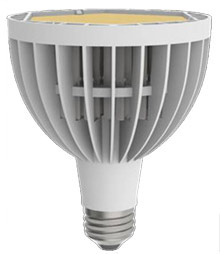 Quantum Dots are getting a lot of attention lately, especially as a new SSL lighting technology. One of the companies that is working on this new tech is QD Vision. Their co-founder and CTO, Seth Coe-Sullivan has agreed to explain the technology, introduce the company, and answer a few questions.
Quantum Dots are getting a lot of attention lately, especially as a new SSL lighting technology. One of the companies that is working on this new tech is QD Vision. Their co-founder and CTO, Seth Coe-Sullivan has agreed to explain the technology, introduce the company, and answer a few questions.
Seth received his Ph.D in electrical engineering from MIT in 2005, writing a thesis on incorporating quantum dots in hybrid organic/inorganic LED structure. That's the technology basis of QD Vision. Seth was chosen as one of the top young entrepreneurs under the age of 30 by BusinessWeek.
QD Vision is a quantum-dot product company that delivers highly differentiated lighting solutions to major industries where color, power and design matter - these include lighting, displays, signage and defense. QD Vision’s Quantum Light⢠platform enables step-change advances over other display and lighting solutions such as LCDs, plasma displays, LEDs and even organic LEDs (OLEDs). QD Vision is privately held, based in MA, US, and has several first-tier patents originating at MIT.
Q: Hello Seth, and thanks for agreeing to do this interview. Can you explain your technology? What exactly *are* quantum dots?
Quantum dots are tiny bits of semiconductor crystals with amazing optical properties that are determined not only by their material composition, but their size. QD Vision synthesizes these materials in solution, and formulates them into inks and films that we sell to our customers, enabling step-change performance and cost benefits. Our first products are Quantum LightTM optics for solid state lighting devices, and our customers offer the most efficient, highest color quality LED lighting solutions on the market today.
Q: How do quantum dots compare with OLED displays or lighting?
Quantum LightTM optics for LED lighting differs from OLEDs in that the products using this technology will be on the market later this year. In addition, the products last 50,000 hours, meet all of the color and efficiency requirements of the DoE's EnergyStar rating system, and are easy for existing manufacturers to integrate into their products without additional equipment purchases or even design changes. Quantum LightTM is here and now, while OLEDs continue to be a future promise.
Q: I see that Quantum Dots can be used together with LEDs or OLEDs to create a display or lighting module. Can you explain how these technologies work together?
The Quantum LightTM platform enables quantum dots to be used to improve the performance of LEDs. Quantum dots warm up the color of the light while increasing its quality (color rendering index), delivering a superior blend of color quality and efficiency that cannot be achieved otherwise. For OLEDs, our inorganic quantum dot technology can potentially replace the organic luminescent materials to provide superior color quality, efficiency, and lifetime. In this solution, the organic charge transport layers from the OLED would simply deliver the charge to quantum dots instead of to an organic dye.
Q: Do you have any partners for OLED panels?
We are collaborating with several Asian display partners to bring this quantum dot technology to market.
Q: It seems like you are putting more emphasis on lighting than on displays... is that correct?
Today, we are emphasizing the products that are ready-to-go, and those are for solid state lighting - correct. However, we have active product development under way for both solid state lighting and displays.
Q: When do you expect your products to be available?
Our first product, an LED lamp developed in partnership with Nexxus Lighting, will be available in the fourth quarter of this year.

Q: What will be the price of this lamp?
Nexxus is currently using a $100 price target for this product.
Q: You have recently won a 700K$ grant for the DOE to develop lighting tech. Can you give us more info?
This program focuses on using QDs to enhance a potential OLED-based lighting product. The QD Vision team will develop and demonstrate a cost-competitive solution to increase extraction efficiency in OLEDs with efficient and stable color rendering index (CRI) for solid state lighting. The end goal of our work with the DoE is practical solid state lighting solutions that are not only power efficient, but also emit light with highly pleasing color qualities.
Q: The last time you have raised money was in April 2008... will you require more funding?
We do anticipate needing another round of funding before we reach cash-flow positive, but our mix of VC and government funding keeps our cash burn-rate extremely low for a 45+ person company.
Q: Where do you see the Display market in 5 years? What role will Quantum dots make?
I think that LCD will continue to dominate the display market for the next five years, and will look like a very mature technology. Quantum dots will be part of many LCD-based displays in their backlight units, enhancing color and efficiency and allowing LCD manufacturers to substantially reduce the cost of the backlight.
Q: Where do you see the Lighting market in 5 years? What role will Quantum dots make in lighting?
I think that five years from now LEDs will have a significant market share in lighting, and that quantum dots will play a big role in their rapid adoption, by providing the warm color quality that consumers demand. The focus on CFL technology will quickly turn to recycling and Mercury remediation, while incandescent bulbs will have been legislated out of existence.
Seth, thanks again for this interview. We'll be keeping an eye open on Quantum dots... good luck to you and QD Vision!

